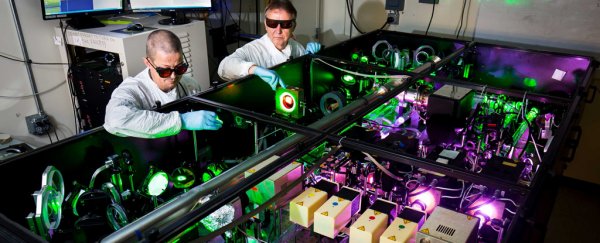A $US2 million upgrade could soon see the world's most intense laser crank it up a notch.
The laser they call HERCULES (because of course it is) is already currently capable of emitting a terrifying 300 terawatts of power. Clearly in a case of laser envy, a few new parts could see it spit out 1,000 terawatt beams of light, enough to produce next generation particle accelerators that could fit on your dining room table.
HERCULES is getting a little old for lasers, being built back in 2007 when 300 terawatts was something to crow about.
That doesn't mean you shouldn't be impressed. Assuming 1,360 watts of sunlight hit your average square metre, 300 terawatts would be more or less like collecting the light that falls on an area the size of Nebraska. And then some.
But what really makes it impressive is that HERCULES focusses all that light to an area that's about a 100th the diameter of a human hair for 30 femtoseconds.
Cue the pew-pew noises. HERCULES holds the record for energy focused on a tiny area, which is 2 x 10^22 (20 sextillion) watts per square centimetre.
However, when it comes to raw power, other lasers are now capable of generating around 2 petawatts – or 2 trillion watts – of energy for about a picosecond.
To make this kind of flash of light, super lasers like HERCULES rely on a technology called pumping. Laser pumps beef up the laser's power by channelling energy from an outside source into some kind of medium.
When HERCULES was first constructed, its engineers had to build its pump lasers from scratch to have any hope of hitting their goal of 300 terawatts.
Now that death-star-type lasers are the coolest things everybody wants one, so better pump lasers are available on the market.
With a grant from the US National Science Foundation, HERCULES can now have a pump laser upgrade that will see it shine with between 500 and 1,000 terawatts of awesomeness.
That will put it in the ballpark of world's most powerful lasers once again.
It should also mean it will blow its old intensity record out of the water, doubling or even tripling its old score.
Why bother, you say?
If you're one of those sort of folk who need a reason for lasers of ridiculous intensity, here's four:
- Intense lasers like HERCULES can kick tiny particles up to crazy speeds in short distances, paving the way for future particle accelerators that can fit inside your laboratory.
- Want high-energy X-rays that can discriminate between soft tissues? Right now the best we can do with X-rays is tell the difference between bone and squishy bits. One day physicians will wonder how they ever managed with such feeble X-ray technology. Thank HERCULES!
- How are gamma ray bursts produced in space? With the recent observation of colliding neutron stars, we're well on our way to understanding this phenomenon better. But we'd learn a lot more if we could generate strong magnetic fields on a microscopic scale, something an intense laser like HERCULES might manage with an upgrade.
- HERCULES could simulate conditions that could be used to study perfect vacuums, allowing researchers to explore how particles pop out of nothingness.
"This upgrade enables a wide variety of different experiments," says Karl Krushelnick, director of the Centre for Ultrafast Optical Science which houses HERCULES.
"There are these exciting applications, and it also opens up a new regime at the very frontier of plasma physics, where quantum phenomena start to play an important role."
We agree they're exciting, and look forward to learning more about gamma ray bursts and ghostly particles.
Long live HERC!
